Razer Blade 15 review: This gaming laptop goes full throttle

 Image: Dominic Bayley / IDG
Image: Dominic Bayley / IDGAt a glance
Expert’s Rating
Pros
Exceptionally sturdy and robustBeautiful and responsive display with very accurate color and crisp detailExcellent connectivity
Cons
You will need to switch to Boost Mode to see frame rates like some rivals Styling is not as suitable for the office as it is for gamingThe display lacks brightness for use outdoors
Our Verdict
The Razer Blade 15 is sturdy and attractive and benefits from a spate of hardware upgrades that will undoubtedly impress most gamers. While gaming performance in Default Mode is still excellent, the laptop truly shines once you boost the GPU.
Price When Reviewed
$2,999 base | $3,699 as tested
Best Prices Today: Razer Blade 15
RetailerPrice $1974.95View Deal
$1974.95View Deal
The 2022 Razer Blade 15 continues to occupy a desirable niche among gaming laptops, providing the kind of sturdiness and high-end visuals you’re more likely to see in a desktop computer, but in a compact and highly portable unit. What’s more, it feels premium and polished in every way, benefiting from years of Razer fine-tuning an exceptional feature list.
Once again, the Blade 15 sports excellent hardware upgrades, no less than a brand new 12th-generation Alder Lake Intel CPU that ensures it continues to be a powerful force among gaming laptops. Although a decent performer in Default Mode, it’s exceptionally powerful in Boost Mode – which only takes a simple click of the mouse to change to.
Razer Blade 15 specifications
The Razer Blade 15 comes in CPU configurations up to Core i9-12900H and with select Nvidia GeForce RTX 30 Series GPUs, the most powerful being the RTX 3080 Ti which we were lucky enough to have in our review unit. Three display types are available, including FHD, QHD or 4K options with varying refresh rates. The specification of our review unit is as follows:
CPU: Intel Core i7-12800HRAM: 32GB DDR5/4800 MHzGPU: Nvidia GeForce RTX 3080 TiDisplay: 15.6-inch QHD (2560×1440), non-touch, 240 Hz refresh rate, G-syncStorage: 1TB SSD PCle Gen4Ports: 2 x USB-C 3.2 Gen 2 (supports power delivery), 3 x USB-A 3.2 Gen 2, Thunderbolt 4 (USB-C), HDMI 2.1 output, SD card reader, 3.5mm combo portNetworking: Wi-Fi 6E, Bluetooth 5.2Dimensions: 0.67 x 9.25 x 13.98 inchesWeight: 4.4 lbs (2.01 kg)Color: Matte blackBattery capacity: 80WHrPrice: $3,699.99
Razer Blade 15 design and build
Finding familiarity in a laptop’s design is a blessing when it comes time to upgrade, granted that there’s always the possibility that choosing something entirely new could land you with an expensive device that doesn’t fit the bill.
The Razer Blade 15, however, is a safer bet, eliciting plenty of buyer’s confidence with its familiar chassis that’s been honed to near perfection with successive Blade 15 releases. At 0.67 x 9.25 x 13.98 inches, it’s identical in size (and shape) to the late 2021 Blade 15, which means it retains its smaller size advantage over 15-inch gaming laptops like the 14.16-inch wide Alienware x15 R2.
At a little over four pounds, it weighs exactly the same as its predecessor – qualifying it as equally light enough to carry in a medium to large satchel – although it should be stated, it’s still comparably heftier to cart around than the current lineup of 14-inch gaming laptops like the Razer Blade 14 (3.92 lbs) and the Asus ROG Zephyrus G14 (3.64 lbs).
The new Blade 15 is just as sturdy as its predecessors as well. Milled from a single block of CNC-aluminum, it feels incredibly solid all over, from the base to the outermost corners of the lid. In fact, my review model proved virtually immovable to my prodding. The hinges too were so tight they could hold the lid open an impressive half inch from the base.
A smattering of legacy features return to grant the Blade 15 a polished top-end appeal. Two that stand out are its 4.9 mm thin display bezels and anodized matte-black scratch resistant coating. These seem like old friends we’ve seen before in recent Razer reviews and they undoubtedly add to the premium feel.
The styling is also mostly unchanged from last year. The fluorescent Razer snake logo taking center stage on the notebook’s top lid is predictably very bold and green. Some gamers may still prefer the more muted styling of the Razer Blade Stealth, whose two-toned logo is a little more office friendly. Still, its look remains slick and since it’s a laptop meant for high-end gamers, there’s really nothing wrong with showing that off.
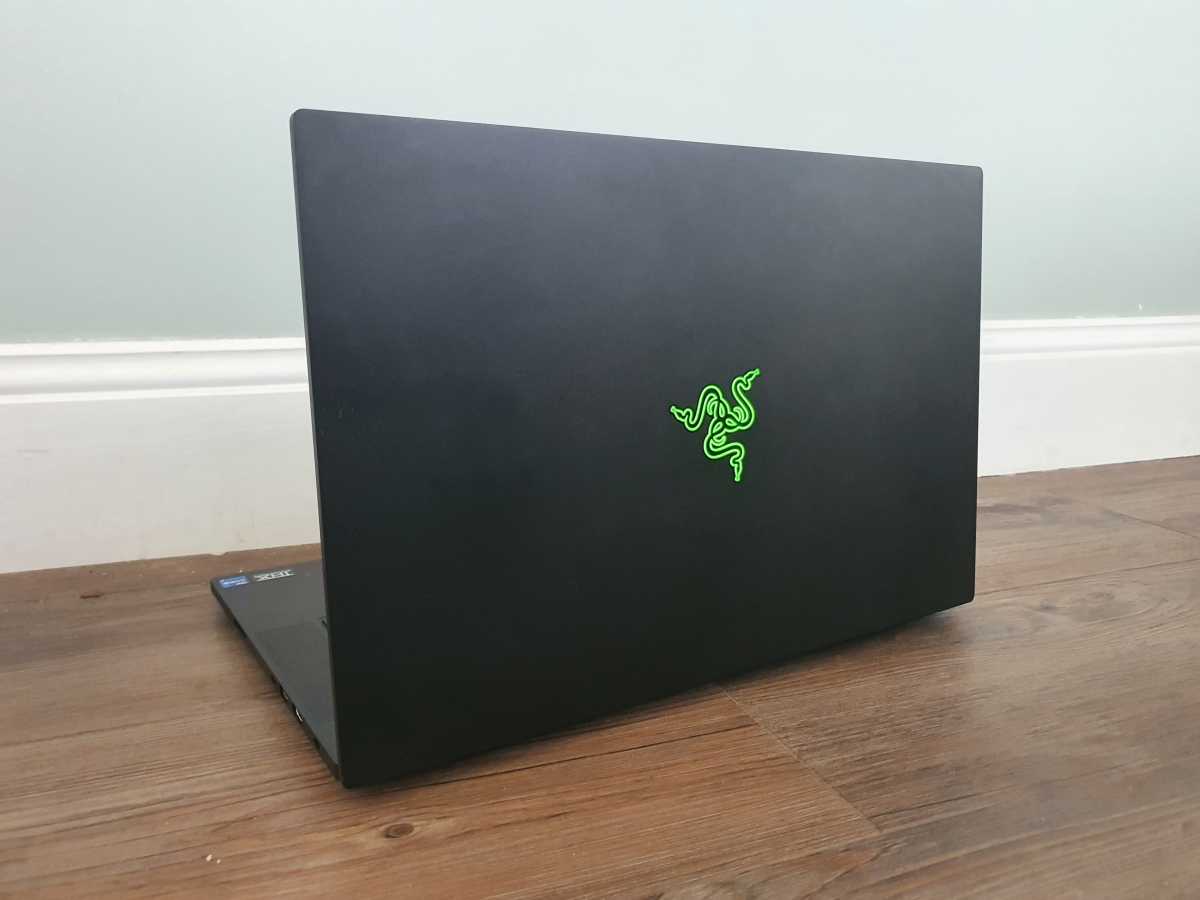
The 2022 Razer Blade 15 sports the same iconic Razer logo on its top lid as last year’s release.
The 2022 Razer Blade 15 sports the same iconic Razer logo on its top lid as last year’s release.
Dominic Bayley / IDG
The 2022 Razer Blade 15 sports the same iconic Razer logo on its top lid as last year’s release.
Dominic Bayley / IDG
Dominic Bayley / IDG
Inherited features aside, minor changes to last year’s model make the Blade 15 a little easier to use. First and most notably is a new position for the power button. It’s been moved from inside the top right-hand side speaker grille to now sit in the top right of the keyboard next to the “del” key, so it’s a lot easier to spot. It’s also now fully sized, so less fiddly.
The speaker grilles have also been modified. They now appear as laser cut perforations in the upper casing, rather than speaker-like material embedded into the casing as they were previously. It’s a cleaner and more cohesive look, but it also allows for a more spacious keyboard than last year’s model – a win win for users.
Keyboard and trackpad
The Blade 15’s backlit keyboard is powered by Razer’s Chroma RGB lighting system, which gives you access to 16.8 million colors and plenty of effects in the Razer Synapse app. It supports per-key illumination for color mapping commands, a feature which we usually only find in the most high-end gaming notebooks, although Razer has also made it a standard feature of the base model Blade 15 this year.
To be sure, the backlighting is the keyboard’s star attraction, beaming color in front of you like a Fourth of July celebration. That’s not to say the keyboard isn’t impressive in other ways, too. It’s both spacious and responsive and the keys are highly comfortable.
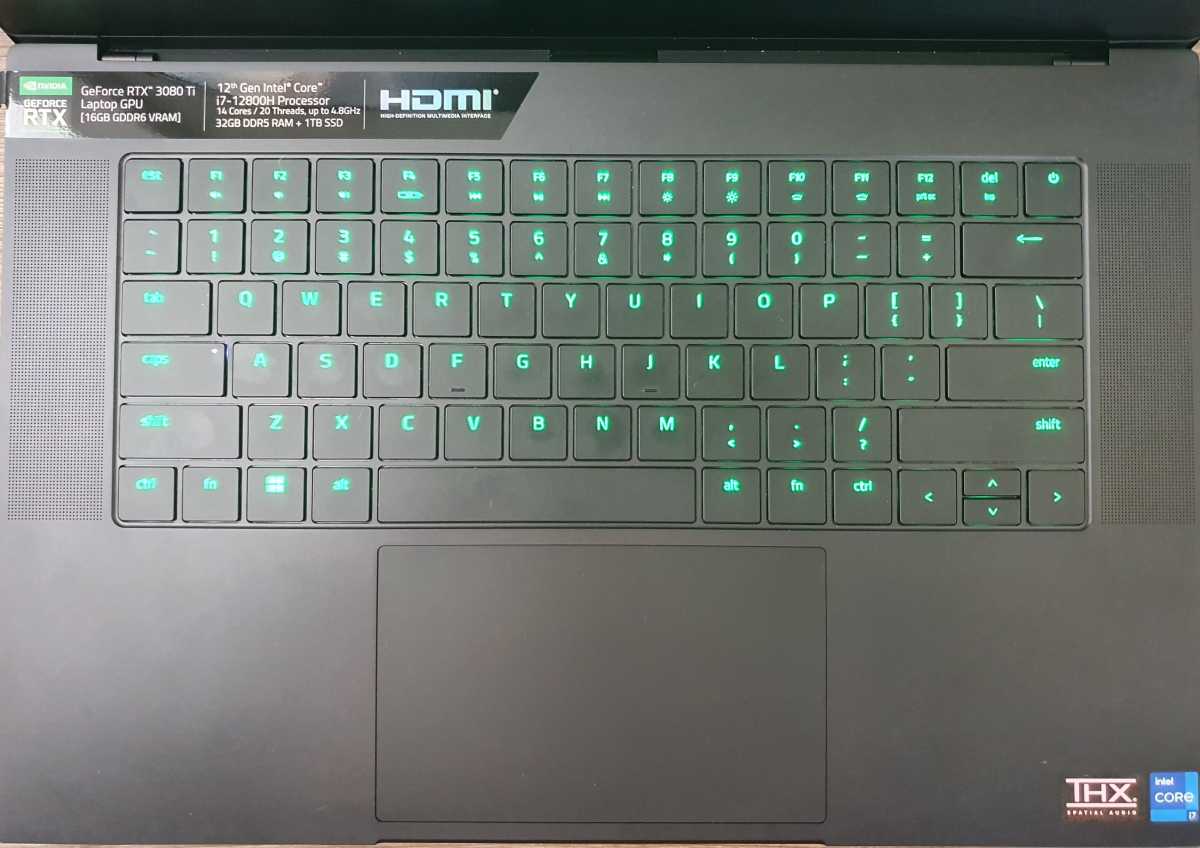
The Razer Blade 15’s Razer Chroma Backlit keyboard.
The Razer Blade 15’s Razer Chroma Backlit keyboard.
Dominic Bayley / IDG
The Razer Blade 15’s Razer Chroma Backlit keyboard.
Dominic Bayley / IDG
Dominic Bayley / IDG
The latter have a low profile, but they bounce back quickly, feeling noticeably less mushy than in some rivals. Surprisingly, they’re also whisper quiet, which may not suit gamers craving the more desktop-like mechanical keyboard experience, but that’s a rarity among gaming notebooks anyway.
As to the layout, it’s fairly typical for a 15-inch laptop. It includes F1 to F12 keys and left and right ‘shift,’ ‘ctrl’ and ‘fn’ keys. There’s no numpad, but you won’t miss it much, since there’s everything else you need, including up and down arrow keys and generously proportioned letter keys for decent typing accuracy.
Once again, Razer has included a Microsoft Precision Glass trackpad, which is both large and very smooth. In both our reviews of the Razer Blade 17 and Razer Blade 14, we found it one of the quickest we’ve used to date and it’s no different in the Blade 15, allowing your fingers to slide over it with minimal contact as if they were sliding over a freshly cleaned windowpane.
Display
The Blade 15 comes in multiple display options ranging from a top-end 4K with 144 Hz refresh rate to a Full HD option with 360 Hz refresh rate. Our review unit’s QHD (2560 x 1440-pixel) display with 240 Hz refresh rate hits a comfortable middle ground between those two, delivering images in fine detail but with the kind of responsiveness you’d expect in a premium laptop.
Testing the display for detail and color balance in Sniper Elite 5, the IPS-grade 100 percent DCI-P3 color panel looked incredibly sharp and had no trouble rendering difficult shapes like rounded objects with precision. Its color reproduction was also spot on – reds looked true instead of appearing orange in hue, while whites didn’t have the blue tinge I sometimes see in some inferior panels – both positive results for gamers and creative professionals alike.
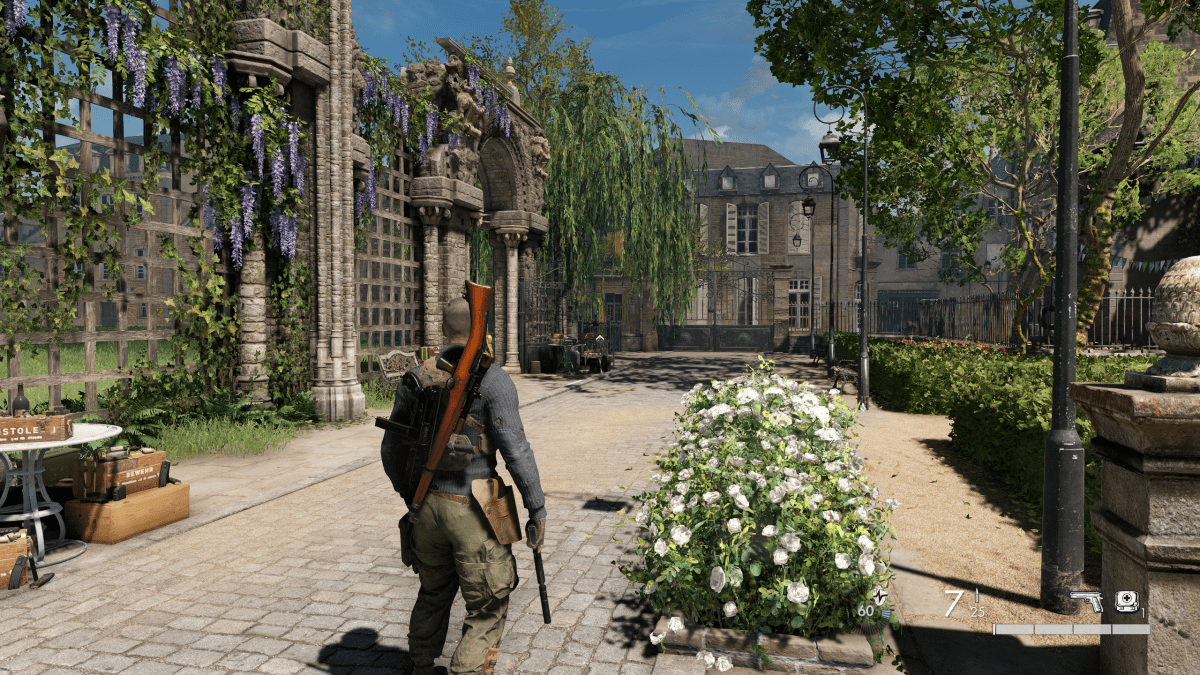
Sniper Elite 5 screenshot taken on the Razer Blade 15.
Sniper Elite 5 screenshot taken on the Razer Blade 15.
Dominic Bayley / IDG
Sniper Elite 5 screenshot taken on the Razer Blade 15.
Dominic Bayley / IDG
Dominic Bayley / IDG
Running an EIZO Monitor test confirmed these results and also provided me with some insight into how well the panel rendered patterns and color gradients. Here, the frequency patterns the Razer produced showed up lines that were clear and defined, even when rendered very small. Color gradients were also free of obvious breaks or bonding, further proving the panel’s worthiness for producing highly detailed text and images.
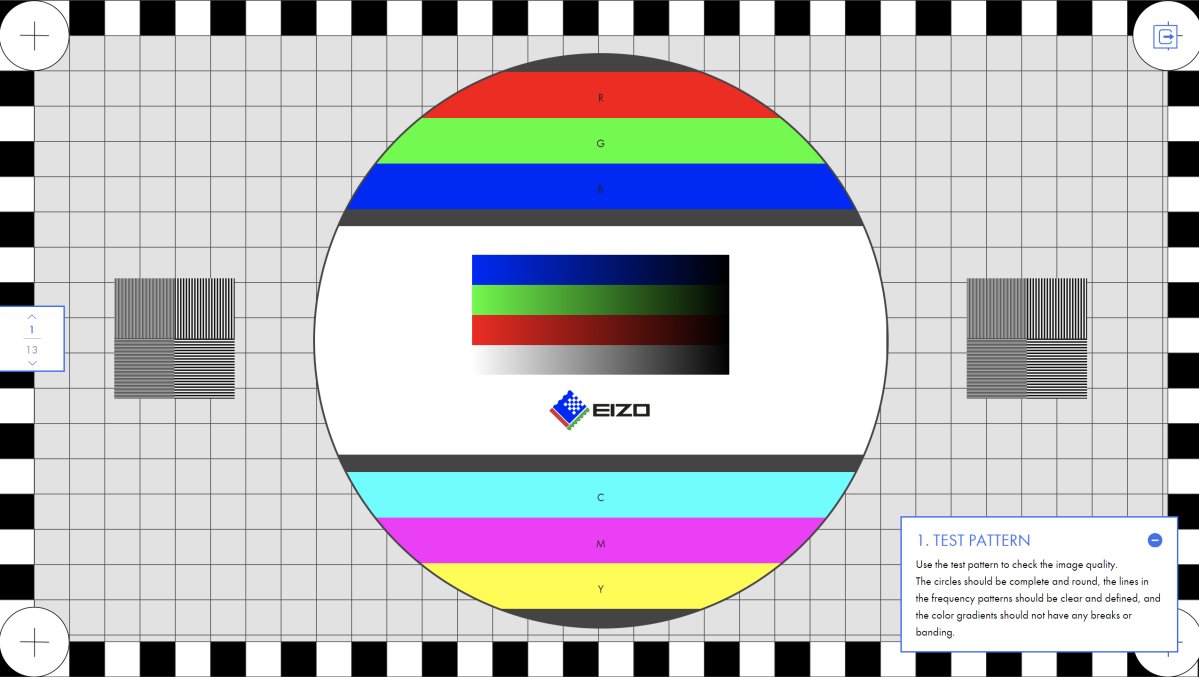
The EIZO test for the Razer Blade 15’s display.
The EIZO test for the Razer Blade 15’s display.
Dominic Bayley / IDG
The EIZO test for the Razer Blade 15’s display.
Dominic Bayley / IDG
Dominic Bayley / IDG
With G-Sync technology switched on, screen tearing all but disappears keeping the videos and animations rolling smoothly. This is a useful addition that makes the display just a little more polished.
Although, a small nitpick is that it could have been a tad brighter. My review unit mustered a peak brightness level of 315 nits as measured by my LUX meter, which was enough to provide decent contrast indoors. Outside though, it was a different story, the display appearing a little washed out when glare made it harder to see.
A lesser qualm is that the panel’s 16:9 ratio remains unchanged. While this didn’t have any impact on my gaming, a taller 16:10 display would have been useful for comparing my Excel spreadsheets, thereby adding to the Blade 15’s versatility as a productivity machine. Still, I liked how the ultra-thin bezels nicely minimized distraction.
Webcam and audio
With more gamers choosing to stream ‘let’s plays’ or upload videos onto social media it’s not surprising that some manufacturers have opted for FHD 1080p webcams over HD 720p ones. Razer is one, the Blade 15’s higher resolution camera providing a welcome boost in image clarity and brightness in my group chats, like in Microsoft Teams.
The webcam’s Windows Hello compatibility also made it super convenient to log on each day, granting me quick password-free access in a matter of seconds. Plus, knowing I was using biometrics provided a little extra surety around the laptop’s security.
With sleeker laser cut speaker grilles in this year’s Blade 15, I was all ears to hear if the audio had changed. Thankfully, the sound is on par with the late 2021 Razer 15 in that it produces naturally sounding mids and high tones, but the bass tones are similarly unremarkable.
Having just reviewed the Razer Blade 17 there’s no doubt its bass comes up trumps here, delivering a presence more akin to a desktop laptop. Even so, for its exceptionally thin chassis, the Blade 15 produces respectable audio.
What’s more, the 7.1 channel THX Spatial Audio works perfectly both with headphones plugged in or via its speakers, so the Blade 15’s immersive surround sound experience is one of the best you can get these days.
Connectivity
The Blade 15 fronts up with a fully modern contingent of ports which should delight gamers and creative professionals craving I/O options for multiple devices. With 2 x USB-C and 3 x USB-A ports as well as a Thunderbolt 4 port, there are slots galore for USB drives, phone chargers and even extra displays.

The Razer Blade 15’s left side ports.
The Razer Blade 15’s left side ports.
Dominic Bayley / IDG
The Razer Blade 15’s left side ports.
Dominic Bayley / IDG
Dominic Bayley / IDG
The USB-A ports conveniently include power delivery, which adds the benefit of bi-directional charging, while a HDMI 2.1 port provides video output, or you can use the Thunderbolt 4 port to connect up to 2 x 4K or an extra 8K display at a 60 Hz refresh rate.

The Razer Blade 15’s right side ports.
The Razer Blade 15’s right side ports.
Dominic Bayley / IDG
The Razer Blade 15’s right side ports.
Dominic Bayley / IDG
Dominic Bayley / IDG
Wireless connectivity options are also top-notch in the Blade 15. You get the newer version of the Wi-Fi 6 standard Wi-Fi 6E, which makes available an extra 14 x 80 MHz and 7 x 160 MHz channels on the newer 6 GHz Wi-Fi band, which ultimately equates to less signal interference and lower Wi-Fi latency than in a laptop with standard Wi-Fi 6.
Meanwhile, Bluetooth 5.2 support ensures you also get the benefit of the latest Bluetooth efficiency improvements, including faster pairing and longer battery life than in laptops with Bluetooth 5.0 or Bluetooth 5.1.
CPU performance
Our review unit came armed with the latest 12th gen Intel Core i7-12800H processor and 32GB DDR5 RAM with a max stock speed of 4800 MHz – two specs that should impress techy gamers.
As one of Intel’s Alder Lake chips, the Core i7-12800H packs a hybrid Core arrangement consisting of 6 Performance Cores and 8 Efficient Cores – it’s a chip which past benchmark results have shown can even outperform the zippy Intel 11th-gen i9-11980HK processor – one of last year’s best.
Among the comparison laptops we chose to pit the Blade 15 against, were the $3,350 15-inch Alienware x15 R2 and $4,000 17-inch Razer Blade 17 – both laptops featuring very capable i7-12700H CPUs and comparably powerful GPUs.
Like the Blade 15, manufacturers have worked wonders to make these gaming laptops ultra-thin but powerful (and cool) enough to rip through AAA games. They’re recent outstanding performers in our synthetic benchmarks, which is precisely the kind of performance we were hoping to see in our first round of Razer Blade 15 tests.
First up, we ran Maxon’s Cinebench R20 Single-Threaded benchmark which tests just a single core of our 14 Core CPU. As expected, the Blade 15’s powerful processor made light work of this benchmark, topping the chart in our comparison field, even dominating the likes of the larger 2022 Razer Blade 17. The takeaway here is the Razer Blade 15 is well suited for running everyday tasks like apps and simple desktop programs.
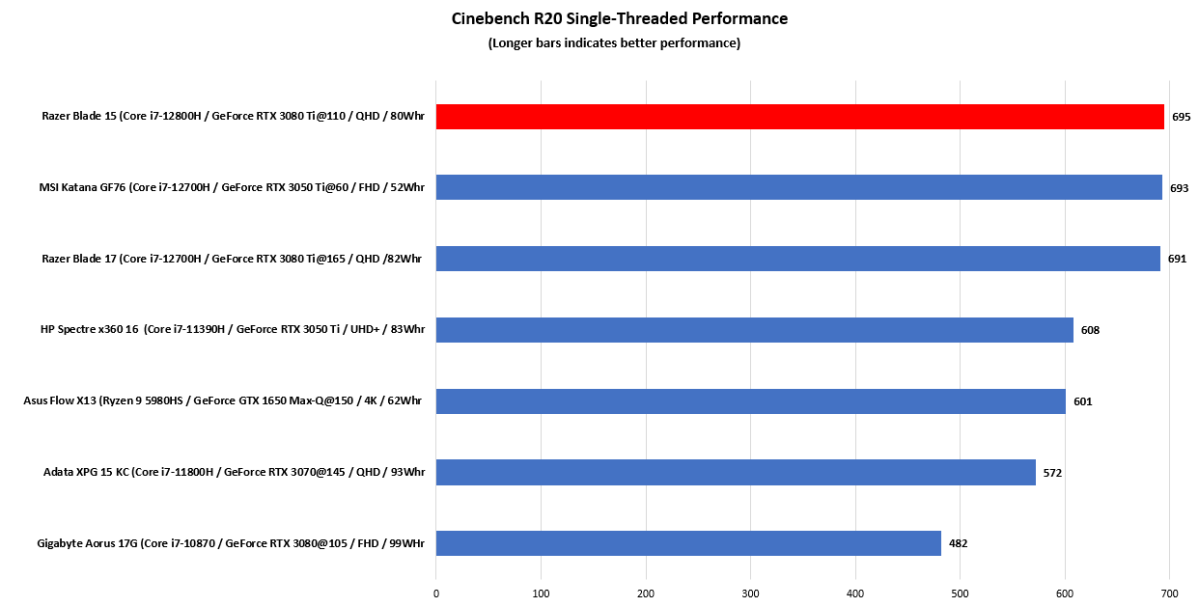
Dominic Bayley / IDG
Dominic Bayley / IDG
Dominic Bayley / IDG
Moving on to Cinebench’s R20 Multi-Threaded benchmark – a more demanding test that utilizes all the cores of our laptop’s CPU – and this time the result was a little less impressive. Still, the Razer Blade 15’s score of 4,234 is consistent with our top performing laptops of 2022 and shows us that the Blade 15 would perform very well if you were to launch a high-end game or undertake CPU-demanding tasks like video editing.
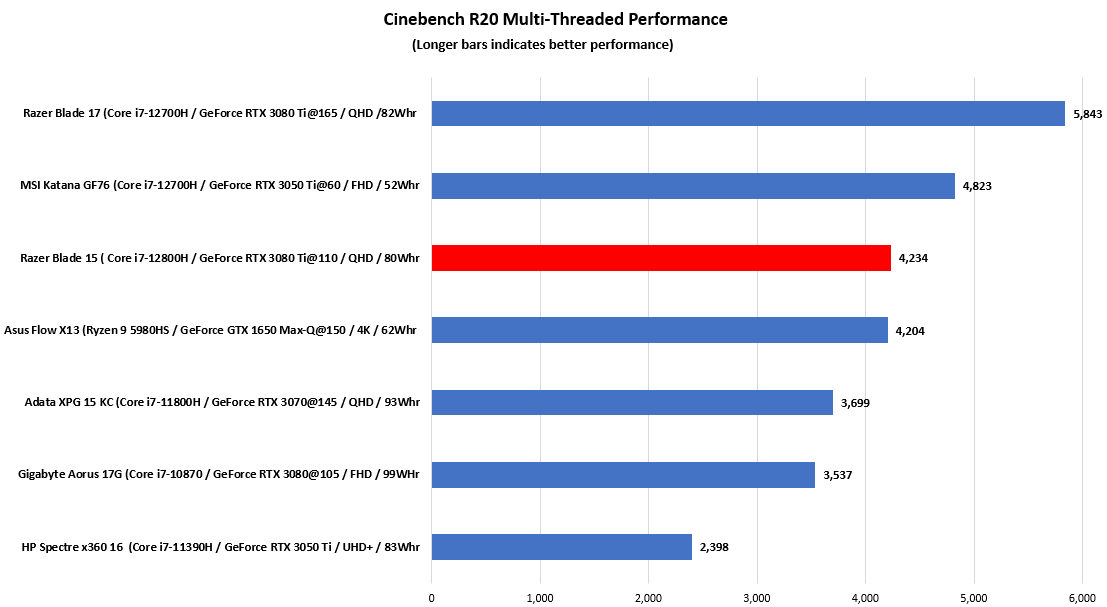
Dominic Bayley / IDG
Dominic Bayley / IDG
Dominic Bayley / IDG
Our final CPU test utilizes the free Handbrake utility and provides an indication as to how well a laptop can carry out a CPU-intensive task before it needs to throttle performance. In this benchmark, we set our Razer Blade 15 the task of encoding a 30GB MKV file to MP4 using the Android Tablet preset.
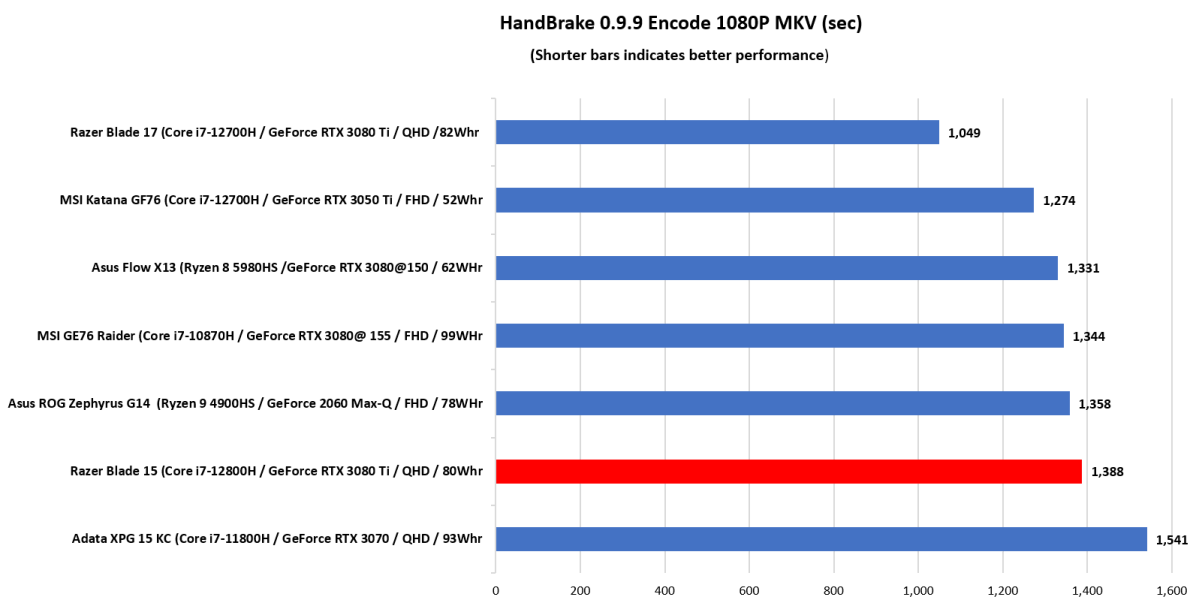
Dominic Bayley / IDG
Dominic Bayley / IDG
Dominic Bayley / IDG
As you can see in the graph, the Blade 15 took considerably longer than the Razer Blade 17 to complete this test and was slightly pipped at the post by the Asus ROG Zephyrus G14 and the MSI GE76 Raider. Switching over to Boost Mode in the Razer Synapse software, however, elicited an entirely different result in Handbrake, the Razer Blade 15’s CPU finishing the task faster than before in a time of 1095 seconds.
Gaming performance
By now we have some idea about the graphics power of the Nvidia GeForce 3080 Ti GPU, having been acquainted with its performance in laptops like the Razer Blade 17. Hence, since we were presented here with the same GPU in the Blade 15 and a new hybrid Alder Lake CPU that can make better use of it, we were expecting solid gaming performance from our review unit.
As a general indication of our laptop’s GPU performance in games, we ran the 3DMark Time Spy benchmark which proved the GPU’s competency in a big way, the Blade 15 scoring better than the majority of our comparisons.
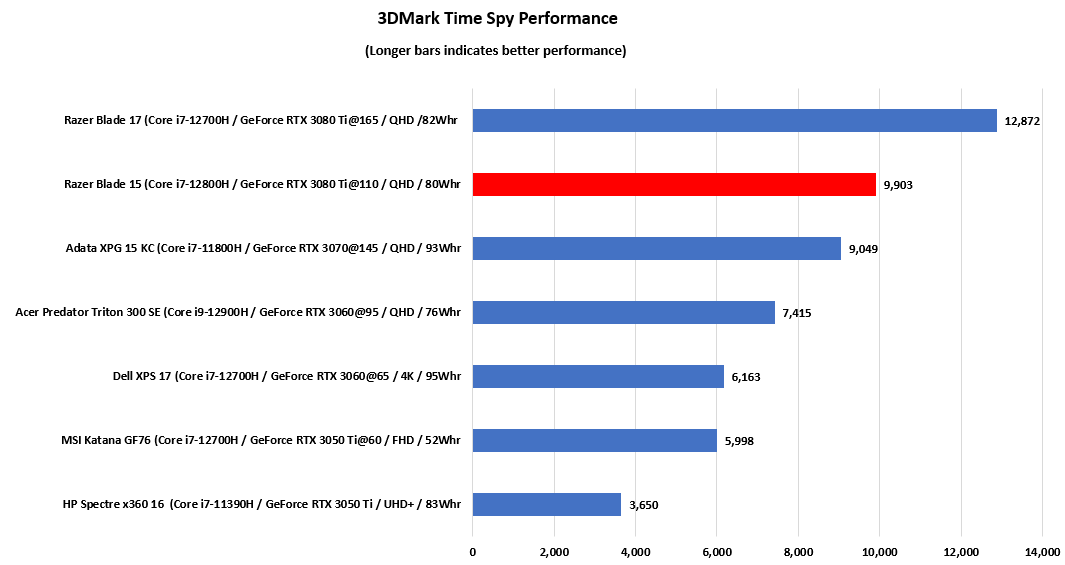
Dominic Bayle y / IDG
Dominic Bayle y / IDG
Dominic Bayle y / IDG
The results from our Metro Exodus and Rise of the Tomb Raider benchmarks, however, were more consistent with our HandBrake benchmark result, the notebook proving a little off the pace of the Alienware X15 R2 and Razer Blade 17, as indicated by its lower frame per second scores.
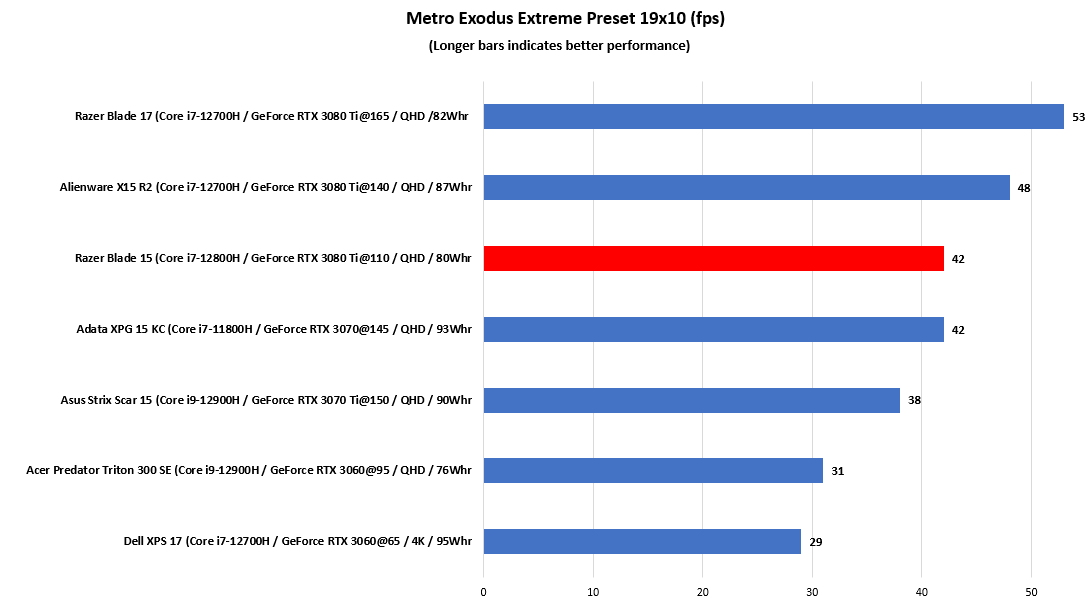
Dominic Bayley / IDG
Dominic Bayley / IDG
Dominic Bayley / IDG
That’s not to say our Blade didn’t achieve decent results. They show the Razer Blade 15 to be one of the top performing gaming notebooks of the year – the kind that would be more than capable of holding its own in just about any modern game you would want to play.
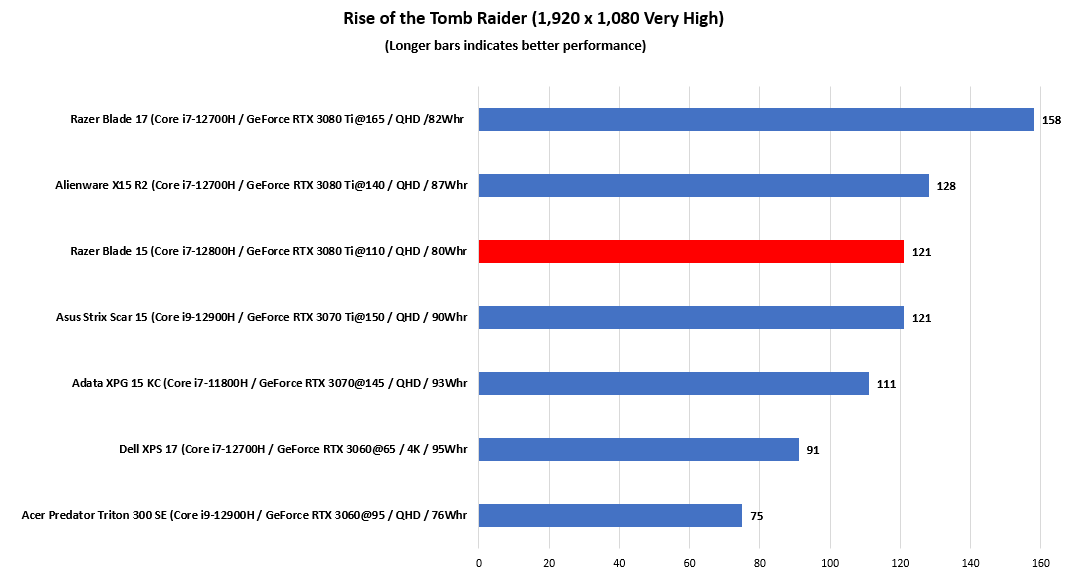
Dominic Bayley / IDG
Dominic Bayley / IDG
Dominic Bayley / IDG
It’s also possible that our review unit might have outperformed our comparisons when each laptop’s CPU was set to Performance Mode, but since we lacked the data to compare our laptops in this way, we can only speculate.
Nevertheless, considering our review unit’s slightly slower result in Balanced Mode, we re-ran the Metro Exodus and RoTTR benchmarks in the Blade 15’s Boost Mode to see if it could achieve similarly quick framerates as the x15 R2 and Razer Blade 17 achieved in their default CPU modes. The outcome? – it certainly can, the Razer Blade 15 scored a more respectable 45 fps in Metro Exodus and a whopping 154 fps in RoTTR.
These results imply the Blade 15’s CPU is really better optimized for its Boost Mode where it can muster higher clock speeds (up to 4.8 GHz) and make lighter work of CPU-intensive tasks where some throttling is likely.
In summary, while the Razer Blade’s performance in Balanced Mode is still very good, switching up to Boost is where the laptop truly excels, and is recommended if you intend on getting equally fast framerates as some of the best laptops this year.
Battery life
The battery lives of the most powerful gaming notebooks varies from as little as a single hour to anywhere up to approximately eight hours these days. Longer is always better, making for a more sociable laptop when gaming with friends away from a power outlet. Considering that, our Razer Blade 15’s battery life proved to be just an average performer lasting just over five hours in our battery rundown test. That means you can expect approximately three hours of gaming time when unplugged.

Dominic Bayley / IDG
Dominic Bayley / IDG
Dominic Bayley / IDG
Conclusion
The latest Razer Blade 15 exudes a reassuring familiarity and sturdiness in its design, propped up by a long list of premium features. Using it is almost always a plush and enjoyable experience. Although a 12th-generation Intel CPU upgrade provides decent gaming performance, our testing shows power users will want to switch to Boost Mode to truly make use of all the extra power on offer.
Best Prices Today: Razer Blade 15
RetailerPrice $1974.95View Deal
$1974.95View Deal
Author: Dominic Bayley, PCWorld Australia Editor
Based in Australia, Dominic Bayley is a hardcore tech enthusiast. His PCWorld focus is on PC gaming hardware: laptops, mice, headsets and keyboards.
Recent stories by Dominic Bayley:
What are hybrid switches in gaming mice?Asus ROG Keris II Ace review: Near perfection in an esports mouseDoes lift-off distance matter in a gaming mouse?








